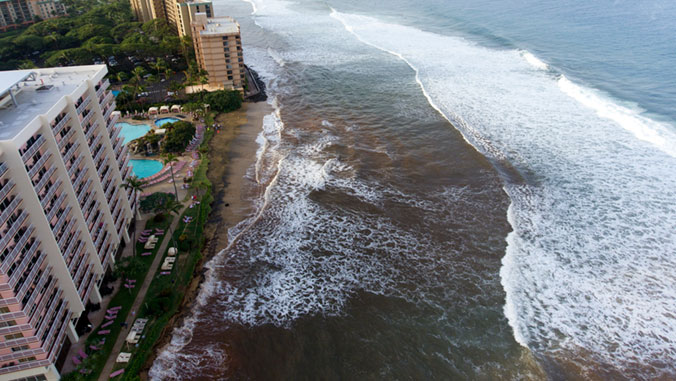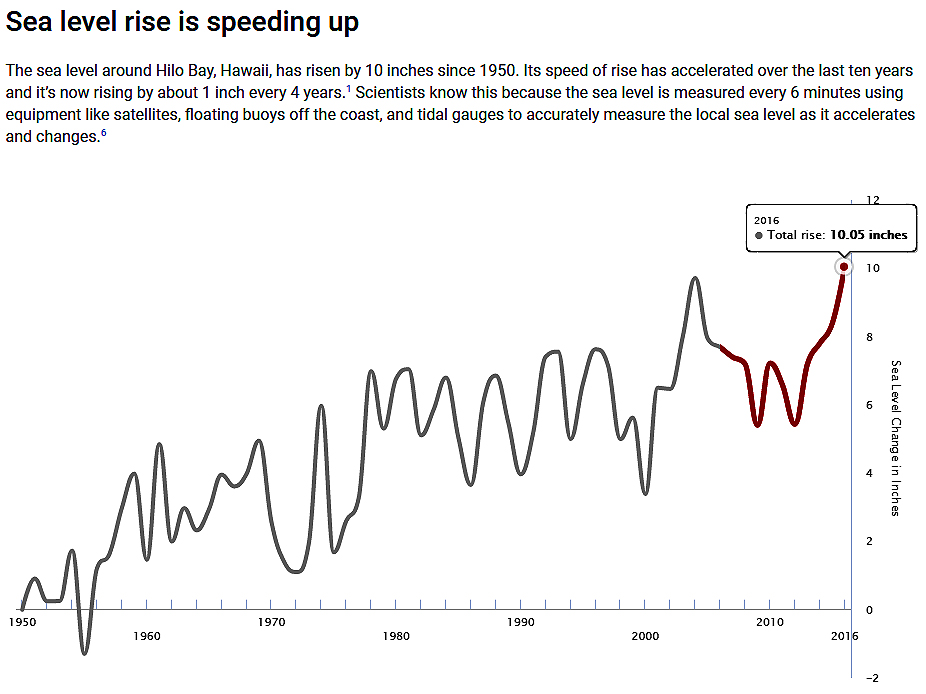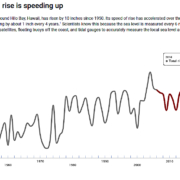The New Climate Reality: Tipping Points, Feedback Loops, Domino Effects
THE CLIMATE SCIENCE
A famous 1960’s song opens with “There’s something happening here, but what it is ain’t exactly clear“… A 4,000 page draft report by the United Nations Intergovernmental Panel on Climate Change (IPCC) makes whatever isn’t clear now perfectly clear in the most recent scientific Climate findings and projections on Earthbound warming impacts.
The in-depth report concludes with these three fundamental warnings in which the public, politicians, and business should heed:
- Unless drastic and immediate action is taken to limit greenhouse gas emissions and keep global temperatures from rising further, life on earth is poised for a catastrophic reckoning
- Mankind may have already missed its opportunity to keep the climate from passing a series of thresholds that will further spur the warming of the planet
- Life on Earth can recover from a drastic climate shift by evolving into new species and creating new ecosystems, the report goes onto state, “Humans cannot”
Tipping points and feedback loops, are perhaps best exemplified by ever increasing melting of the Artic permafrost, which in turn releases methane gas trapped in the ice and then into the atmosphere. Methane releases further amplify the greenhouse gas effect, pushing temperatures even higher. As a result of the melting of the polar ice caps and loss of sea ice, the earth absorbs far more of the sun’s ultraviolet radiation and heat, which further contributes to ice melt.
Jennifer Francis, a senior scientist at the Woodwell Climate Research Center is not optimistic. “…It’s not just because of those feedbacks, it’s because we’ve already put so much carbon dioxide into the atmosphere, and that carbon dioxide lasts a very long time,” “A molecule of carbon dioxide, on average, lasts about 100 years in the atmosphere. So we haven’t yet felt the impacts of the carbon dioxide that we’ve already put in the atmosphere.”
The report warns of “progressively serious, centuries’ long and, in some cases, irreversible consequences.” The report also said that the millions of people who live along coastlines almost everywhere around the world could be battered by multiple climate calamities at once: drought, heatwaves, cyclones, wildfires and flooding.
Nothing in the IPCC report should be a surprise, as all the information comes from the scientific literature. But put together, the stark message is that increasingly severe heatwaves, fires, floods and droughts are coming our way with dire global impacts, and Hawaii’s remoteness will not protect us from the consequences of humankind’s unabated burning of fossil fuels.
On top of this are the irreversible changes now underway. These tipping points, such as where high temperatures and droughts means the world’s forests (temperate and rainforests) may not survive. Altogether, Climate-induced tipping points will be like toppling dominoes, with social, environmental and economic damages impacting food supplies, transportation, energy, industry and social infrastructures within the next few decades – impacts which are already well underway and accelerating.
THE ECONOMY
Climate change is already taking a toll on the global economy, and forecasts predict worse is to come by mid-century (2050).
In a worst-case scenario, if Earth’s temperature rises four degrees Celsius above pre-industrial levels, global GDP could decline 10 to 23 percent compared to a world without warming
- Expected damages for 136 major coastal cities were calculated at between $1.6 trillion and $3.2 trillion by 2050 in a worst-case scenario without adaptation
- Storm surges enhanced by sea level rise threaten more than 40 percent of coastal nuclear power plants worldwide
- Nearly 14 percent of the world’s sandy beaches face severe erosion or elimination by 2050, even under the most moderate greenhouse gas emissions scenario (island states like Hawaii will be hardest hit)
- Average global economic damage due to floods over the last several decades has averaged $50 billion to $350 billion annually, depending on methods of calculation (the Property and Casualty insurance industry in the United States accounted for nearly three quarters of trillion USD in premiums written in 2019 – and are now facing severe economic adjustments in this new climate reality)
- In Africa alone, a decline in rainfall from 1960 to 2000, attributed to climate change, widened the GDP gap between Africa and the rest of the developing world by 15 to 40 percent. Heat and scarce rain are adding obstacles to global agricultural, but presently hardest hit is Africa. with a highly uncertain economic future, while facing greater social instability and forced migration – which in turn will produce ripple effects far beyond the region
In the Asia-Pacific region, rising sea levels are threatening to cause havoc across Asia-Pacific, from Bangladesh to China to Australia. The IPCC projects sea level rise up to 1.1 meters by 2100.
- In South Asia, water-related impacts of climate change are expected to reduce GDP up to 2.5 percent by 2050 if global warming exceeds two degrees Celsius
- Asia could experience direct losses of nearly $170 billion with half-a-meter of sea level rise, and damages will be concentrated in China
- In Bangladesh, for example, one-third of power plants may need to be relocated by 2030 due to sea-level rise, and even more so is the case with Japan nuclear energy dependent economy
- Climate-induced loss in Australian agricultural and labor productivity could exceed $14 billion by 2030 and $159 billion by 2050, and these figures do not account for economic losses associated with climate-driven die-off (now underway) of the Country’s Great Barrier Reef marine ecosystem.
AND HAWAII; sea-level rise is accelerating
Sea level rise is a statewide problem with the entire Hawaiian chain of islands impacted. The sea level off Hawaii’s various coastlines is up to 10 inches higher than it was in 1950.
For MAUI, sea level rise impacts are mostly due to ice melting into the ocean and is causing major issues. With sea-level rise, an increase in wave plus tide-driven flooding has led to worsening coastal erosion in the Honokōwai area of West Maui in recent years.

For HAWAII ISLAND, the sea level around Hilo Bay, Hawaii, has risen by 10 inches since 1950. Its speed of rise has accelerated over the last ten years and it’s now rising by about 1 inch every 4 years. Scientists know this because the sea level is measured every 6 minutes using equipment like satellites, floating buoys off the coast, and tidal gauges to accurately measure the local sea level as it accelerates and changes.

And for OAHU, increases in sea level currently threatens Honolulu’s famous Waikīkī district.

Droughts, floods, and fire …
Weather intensity swings in Hawaii are increasingly impacting the islands.
Hawaii may be graced with tropical forests, making parts of the islands some of the wettest places on the planet, but it is also increasingly vulnerable to wildfires. Heavy rains encourage unfettered growth of invasive species, including guinea grass, and dry, hot summers make them highly flammable.
Similar to the American West, where dozens of large blazes have raged in recent weeks and fire seasons have grown worse over the years because of extreme weather patterns and climate change, about two-thirds of Hawaii faces unusually dry conditions this summer.
Some of the recent fires, especially on the Big Island and the island of Maui, ravaged areas spanning about 10,000 acres. From 2018 through last year, at least 75,107 acres across the islands have been lost to wildfires, by far the most devastating stretch in a decade and a half.
While the fires showcase several challenges that Hawaii shares with states in the West, including the spread of highly flammable invasive grasses, authorities in Hawaii also cite other factors that make Hawaii unique. Those include big shifts in rainfall patterns over the archipelago and tourism’s eclipse of large-scale farming in Hawaii’s economy, allowing nonnative plants to overtake idled sugar cane and pineapple plantations.
Solutions?
Hawaii can be complicated because each island is affected differently by sea level rise and flooding, but the impact is felt by all islands collectively.
The state is planning over $6 billion in sea level rise solutions, which include port and canal improvements, dredging, and restoration of wetland habitats.
Extreme flooding events in some U.S. coastal areas could double every five years if sea levels continue to rise as expected, according to a study published in Scientific Reports.
Today’s “once-in-a-lifetime” extreme water levels— are currently occurring every decade— and are projected to be exceeded by daily event along most of the U.S. coastline before the end of the 21st century.
The return on investment in converting to a clean energy economy, and as a result, capping global warming at 1.5 degrees Celsius rather than two degrees would increase per capita GDP five percent across the developing world and potentially more so for developed economies by mid-century. UN estimates project up to 20 percent increase in global GDP by 2100. Even more importantly, a rapid transition to a clean energy will help ensure a prosperous and healthy future for Hawaii and the planet.
Major steps forward —
Hawaii had a very productive 2021 legislative session, passing several laws which pave the way to the state’s clean energy future and protecting stakeholders from sea level rise impacts. Gov. David Ige signed unto law the following bills addressing climate change:
HB 243 requires state agencies to identify facilities that are susceptible to sea level rise and flooding. The agencies also will need to send an annual report to the governor. The state is also required to prepare mitigation plans for these facilities.
SB 474, requires anyone selling a home to disclose if the property lies in a sea level rise exposure area. According to a 2017 report from the National Oceanic and Atmospheric Administration, the global mean sea level will rise 3.2 feet by 2100. In a more extreme scenario, that level can be reached by 2060.
HB552 – Establishes clean ground transportation goals for state agencies on a staggered basis until achieving a 100 percent passenger vehicle clean fleet by 12/31/2030, 100 percent light-duty motor vehicle clean fleet by 12/31/2035, and all light-duty motor vehicles in the State by 12/31/2045. New purchases of light-duty motor vehicles must be zero-emission by January 1, 2022.
HB424 – Requires all state and county entities, when renting a vehicle on behalf of a state employee in the discharge of official government business, to rent electric or hybrid vehicles.
HB1142 – Allocates 3 cents of the barrel tax to fund the installation and statewide build out of an EV infrastructure; charging systems, along with enforcement of 297-71 HRS – penalties for failure to comply with the requirement to install and maintain charging stations; while at the same time authorizing penalties for improper parking in an EV charging stall.
Clearly, the state’s goal for 100% clean and renewable energy needs legislative updating, coupled to greater cooperation and participation by the state’s largest utility; Hawaii Electric in a transition off fossil fuel power plants, which the power the state’s economy — a problem not unique to Hawaii in states which have taken a leadership role in transitioning their power grids to clean and renewable energy.





Leave a Reply
Join the Community discussion now - your email address will not be published, remains secure and confidential. Mahalo.